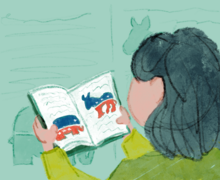Arizona professor talks about community activism at U.S.-Mexico border
Izzy Bartling | Asst. Digital Editor
Michelle Téllez, from the University of Arizona, led the discussion entitled, “Liberating Stories of Resistance Along the U.S./Mexico Border” on Tuesday night in Sims Hall.
On Tuesday, a group of students and community members gathered at Sims Hall for a dialogue about the U.S.-Mexico border. Michelle Téllez, an assistant professor at The University of Arizona, led the discussion.
The women’s and gender studies department and the Syracuse University Humanities Center co-hosted the event. As an assistant professor in the Mexican American studies department at UA, Téllez’s scholarly work focuses on cross-border labor organizing, gender migration and autonomy, as well as resistance along the U.S.-Mexico border.
However, Téllez wasn’t there to discuss the current rhetoric surrounding the border: one revolving around violence, trespassing and illegality. Instead, she was there to talk about the border as a place people call home.
“Because I grew up along the U.S.-Mexico border, I have a different vision of the border, and it’s this vision that people live and work along the U.S.-Mexico border,” Téllez said.
Growing up in San Diego, adjacent to Tijuana, Mexico, Téllez’s experiences with racial and cultural exclusions greatly shaped her identity as a scholar and activist, she said. It also shaped her perspective of the world and her dreams for the future. Most of her work has to do with sharing the untold narratives of border dwellers.
Téllez began her lecture discussing the brutal working conditions in maquiladoras, or factories, that are used by transnational companies seeking cheap labor provided by border dwellers, especially women.
Workers make as little as $50 per week, have to work overtime, and face sexual and racial harassment, Téllez said. Some processes, including imposing pregnancy tests on women to ensure their suitability for working, have stripped women of their humanity, she said.
As a result, communities in the borderlands have reached out to each other for help, looking for ways to rise and fight against these injustices. Community activists have begun using art, including murals, to spread their stories along with messages of resistance.
Téllez projected the work of Mexican artist Ana Teresa Fernández, who paints murals on parts of the U.S.-Mexico border fence. One of the murals is painted the color of the sky to give the illusion that the physical border is not actually there. Téllez also showed audience members a video of the artist explaining that despite the wall, we all live under the same sky.
One of the community-focused art projects Téllez worked on in Arizona was called “Entre NosOtr@s,” which focused on creating “community-embedded events in collaboration with Chicana/Latinx/indigenous women and gender-nonconforming artists.” The group gathers artists from all over the country to help the community by leading dialogues about gender, sexuality and culture across borders.
Chandra Talpade Mohanty, long-time friend of Téllez and professor of women’s and gender studies, said Téllez’s first-hand work with the borderland communities provides an important perspective.
“The importance of having these kinds of conversations at Syracuse University…is to highlight that there are stories about the border that are not the same as the ones that the media perpetuates,” she said.
The U.S.-Mexico border is a very violent, militarized space, Mohanty said, but the stories of resistance among communities and how they’re creating spaces of liberation through art tells a different side of the story.
Joshua Ratel-Khan, a graduate student studying communication and rhetorical studies, agreed in the importance of the conversation.
“Since this is a border issue that Syracuse University doesn’t necessarily come into contact with on a daily basis,” he said, “I think bringing these realities of other people’s lives to the forefront is really important.”
Published on October 1, 2019 at 11:13 pm





